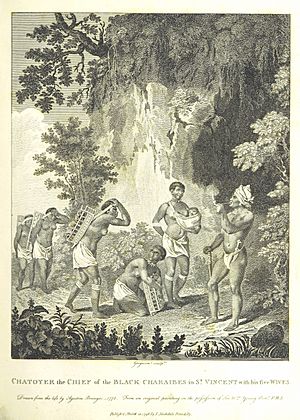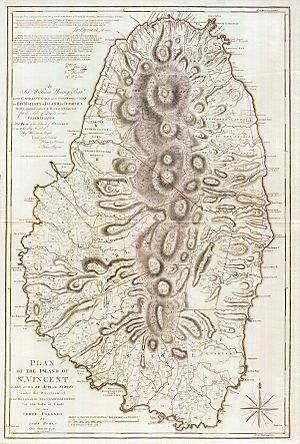First Carib War facts for kids
Quick facts for kids First Carib War |
|||||
|---|---|---|---|---|---|
 Depiction of treaty negotiations between Black Caribs and British authorities on the Caribbean island of Saint Vincent in 1773 (1910) |
|||||
|
|||||
| Belligerents | |||||
| Garifuna | Kingdom of Great Britain | ||||
| Commanders and leaders | |||||
| Joseph Chatoyer | Governor Robert Melvill Governor William Leyborne Leyborne Admiral Robert Mann Major-General William Dalrymple |
||||
| Units involved | |||||
| 1500-3000 Men | 6th Regiment of Foot 14th Regiment of Foot 31st Regiment of Foot 32nd Regiment of Foot 68th Regiment of Foot 70th Regiment of Foot St. Vincent Militia |
||||

The First Carib War was a fight between the Carib people of Saint Vincent island and the British army. It happened from 1769 to 1773. The British wanted to take more land on the island, which led to the conflict.
Contents
Why the War Started
Saint Vincent is an island in the Caribbean. For many years, both Britain and France tried to control it. They wanted to build large farms called plantations there.
In 1763, after a big war, Saint Vincent became British land. This was part of the Treaty of Paris (1763). British governors, like Robert Melvill, then took charge. They wanted to grow the island's economy. This meant taking more land, which often belonged to the native Carib people. This caused problems between the British and the Caribs.
The Conflict Begins
Early Problems
Things got worse in 1769. A group of British surveyors, who were mapping land, went into Carib territory. They were trying to build roads. The Carib people took them hostage.
The Carib leaders, led by Joseph Chatoyer, worried that the British would try to invade their land. They secretly contacted the French government on the island of Martinique. They bought weapons from the French to defend themselves.
In September 1769, an American ship crashed near the island. Its crew was killed. The Caribs, now with firearms from the French, became a bigger challenge for the British. In November 1770, Britain sent three army groups from Ireland to protect British settlers on Saint Vincent and other islands. By late 1771, the British found out that the Caribs were indeed working with the French governor of Martinique.
British Attack
The British governor, William Leyborne Leyborne, was frustrated. In 1772, he asked Britain for more help. The British government decided to send more soldiers to the island. They wanted to quickly defeat the Carib resistance. Some officials worried about hurricane season, but the plan went ahead.
As summer arrived, more soldiers came to Saint Vincent. These included groups from the 32nd, 68th, and 70th Regiments. They came from other Caribbean islands. Also, the 6th and 14th Regiments arrived from America. Admiral Robert Mann brought a British navy fleet to the island. His job was to stop the Caribs from getting help from Martinique.
The invasion started in September, led by Major-General William Dalrymple. The main British force moved north from Kingstown. Other soldiers landed on beaches further up the coast. Their main goal was to capture the mountains in the middle of the island.
In January 1773, a group of British soldiers was ambushed by the Caribs. Their leader, Ralph Walsh, was killed. He was the highest-ranking British officer to die in the war.
Despite having many soldiers, the British faced problems. Many soldiers got sick and died from diseases. The hot, wet weather also caused many deaths. Half of one regiment died before they even fought. Food supplies ran low, and the British had to rely on shipments from America. The Carib fighters, about 1,500 to 3,000 strong, fought back with ambushes. They also attacked British plantations to cut off their food.
Ending the War
The war was not popular back in Britain. Many people in the British Parliament thought the war was a waste of money and soldiers. They believed Britain was unfairly taking Carib land.
Because neither side could win completely, a peace agreement was signed in 1773. This agreement set clear borders between the British and Carib areas on the island.
See also
Images for kids





